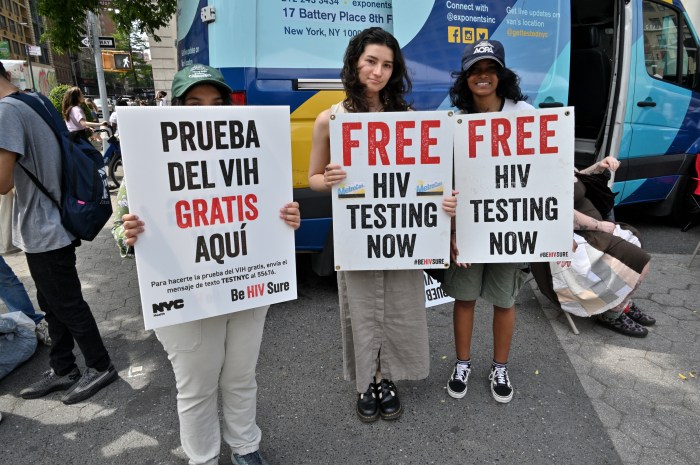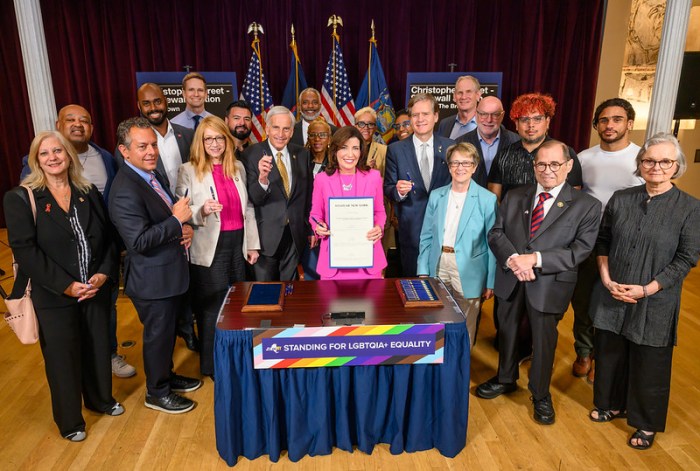BY LAWRENCE D. MASS, MD | Research presentations by AIDS epidemiologists and medical doctors offer ample understanding of the impact of harm reduction in preventing or slowing the spread of HIV. When it comes to preventing the virus' transmission, the two biggest harm reduction innovations have been needle exchange and safer sex approaches conceptualized and implemented in the US in the mid-to late 1980s.
I work in addiction medicine, specifically methadone maintenance, which fosters needle exchanges and offers opiate-injecting addicts a means of obtaining opiate medication without the use of needles. It has emerged as one of the most effective harm reduction tools.
Two decades later, how do needle exchange and safer sex campaigns compare in terms of results? Harm reduction successes have been stunning in the case of needle use and addiction. HIV rates among needle-using addicts in New York -still the epicenter of AIDS among injection drug users – are down by as much as 80 percent. So much for former New York City Mayor Ed Koch's observation that needle exchanges were an idea whose time had not come and would never come for our city.
Much of this success would have been impossible but for the work of early activists in ACT UP, passionate fighters who bucked the system with a mission of life-saving, the results of which they can be justly proud and likely are beyond their most outsized hopes. Their pioneering advocacy on needle exchange sits alongside ACT UP'S work in spearheading the push for anti-retroviral treatments, which have transformed HIV disease from a certain death sentence to a chronic condition very often compatible with longevity and high quality of life.
Encouraging the use of these treatments led to another clear success of harm reduction – the prevention of HIV transmission from mother to fetus. The success rates in New York now approach 100 percent.
What about the impact of safer sex harm reduction efforts on the rate of sexual transmission of HIV? Have they achieved comparable success?
There is no doubt that safer sex practices have prevented and continue to prevent countless cases of HIV transmission, but the results of this harm reduction approach offer a more complex, variable, and ultimately disappointing picture.
Not only are the declines in new HIV cases these days a lot less dramatic among the sexually active, they are nonexistent or worse in some populations. We are seeing increasing rates of infection, sometimes dramatic, and often accompanied by escalations of other STDs, now including MRSA, the multi-drug-resistance strain of staph. And that phenomenon has been seen in diverse settings – among inner-city men who have sex with men; in the 13-19 year-old demographic, especially black and Latino; in those who use crystal meth; and among middle-aged and older gay men.
It seems clear that safer sex approaches, not to mention abstinence, however intermittently successful, do not currently achieve anywhere near the success of needle exchange in reducing the transmission of HIV. I strongly agree with Gay City News' s condemnation of panic-mongering in the media – articulated in Duncan Osborne's critique of the recent New York Times story on the spread of MRSA in gay men.
But we must recognize that until we find a way to achieve the same sort of success in our harm reduction efforts on safer sex that we've seen through needle exchange, the gay community will have to navigate the tempests of prejudice stirred up every time there is an outbreak or upsurge of infection among us. Coming up with such an approach should earn the innovator the Nobel Prize, a recognition already overdue to ACT UP for its collective achievements.
In the meanwhile, we have no choice but to continue the painstaking work of harm reduction through safer sex, neighborhood by neighborhood, demographic slice by demographic slice, region by region, individual by individual, and, with the migration of sexual hook-up opportunities to the Internet, communications technology by communications technology.
But we need to do this work more innovatively, diligently, consistently, and intensively than we currently are. Perhaps then we will flatten the spikes of outbreaks and lower the rates of new cases to an extent that will be comparable to the successes currently attributable to needle exchange.
Should we close the bathhouses and shut down sex parties? That would make no more sense than expecting to reach needle-using addicts by shutting down shooting galleries and preventing access to clean works. If needle exchanges are the model to emulate, we must find new ways to make safer sex more accessible and appealing, by utilizing rather than eliminating or even policing the venues where sex takes place.
In the 1980s, we thought of safer sex initiatives as a stopgap in advance of a preventive vaccine we felt certain would be forthcoming. Dr. David Sencer, the city's health commissioner, for one – and I agreed with him – did not believe, on the basis of STD history and experience, that sexual behavior would prove particularly amenable to change, at least in the long term. Safer sex options and regulations might be effective in some contexts, but we felt that even where most successful there would be periodic breakdowns.
What we could not foresee at that time was just how elusive an HIV vaccine – and, for that matter, a vaccine for hepatitis C, a virus even more transmissible via contaminated blood – would prove to be. With a vaccine still nowhere in sight, we have no choice but to redouble our efforts at safer sex and harm reduction, undaunted by periodic setbacks, such as those to which we can no longer turn a blind eye.
In the spring of 1981, Dr. Lawrence D. Mass, writing in the New York Native, became the first to report on the emergence of what came to be known as AIDS. He is a co-founder of Gay Men's Health Crisis and the author/editor of “We Must Love One Another Or Die: The Life and Legacies of Larry Kramer.”


































